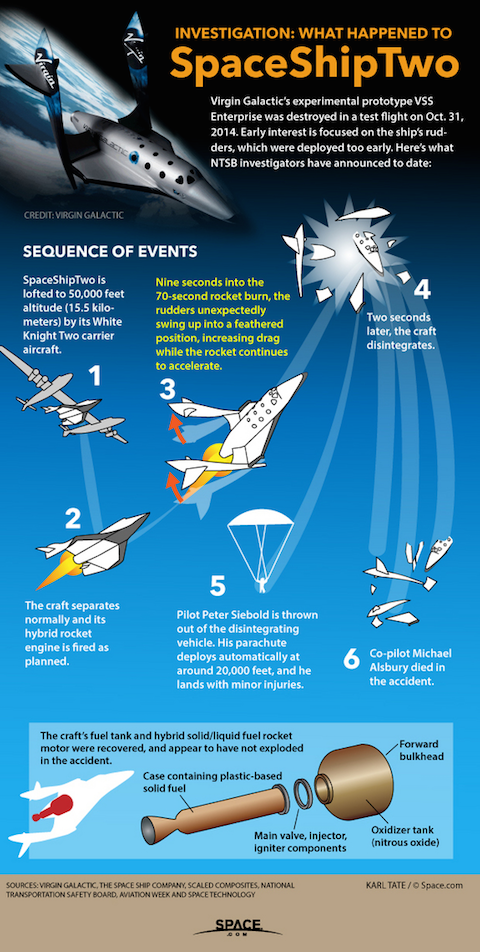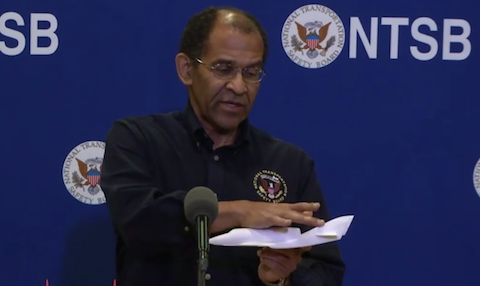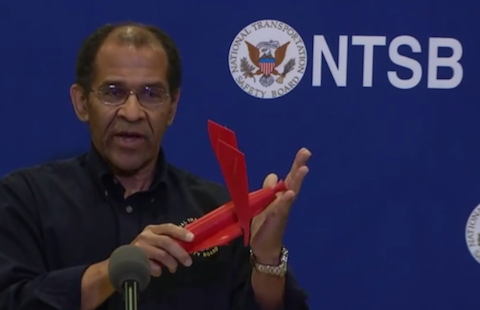'This Week in Airline Safety' for 7 November 2014 discusses how the SpaceShipTwo mishap led to a rethinking of how AirSafe.com will look at space related safety and risk. Read the recent AirSafeNews.com article for further details about those changes.
Virgin Galactic SpaceShipTwo crash
The following is an overview of the crash and accident investigation involving the Virgin Galactic SpaceShipTwo vehicle.
31 October 2014; Scaled Composites; Model 339 (SpaceShipTwo); N339SS; near Cantil, CA: The vehicle, which is designed to fly into the lower reaches of space (above 100 km above Earth) was on its first powered test flight with a new engine fuel and oxidizer combination (nylon and nitrous oxide). SpaceShipTwo was dropped from its carrier vehicle White Knight Two at about 45,000 feet, and ignited its engine.
Roughly fifteen seconds after release from the carrier aircraft White Knight Two, the SpaceShipTwo vehicle experienced an inflight breakup. One of the two crew members, Michael Alsbury, was killed, and the other crew member, Peter Siebold, was able to parachute to safety.
Prior to the accident flight, there had been the 54 test flights of SpaceShipTwo, of which 34 involved a release from the carrier aircraft, including three powered flights.
Scaled Composites, which conducted the flight test, is a partner of Virgin Galactic, which had planned on using SpaceShipTwo to take passengers on suborbital trips into space in the near future.
Additional resources
Deaths associated with US space programs
Fatal space missions
Summary of the fourth NTSB briefing on 3 November 2014
During the fourth media briefing on the third day of the on site portion of the NTSB investigation of the crash of SpaceShipTwo, the most significant information provided by acting NTSB chair Christopher A. Hart was a general timeline of the events between the release of SpaceShipTwo from its mothership WhiteKnightTwo, and the loss of telemetry from SpaceShipTwo. In that roughly fifteen second span, a number of events occurred inside SpaceShipTwo:
- SpaceShipTwo released from mothership WhiteKnightTwo at 10:07:19 PDT (17:07:19 UTC)
- The rocket engine was ignited about two seconds later.
- About eight seconds later, and 10 seconds after release, SpaceShipTwo was traveling at about Mach 0.94
- Sometime during the next two seconds, the feather lock handle was moved from the locked to the unlock position by the person sitting in the right seat.
- At about 12 seconds after release, the vehicle was traveling at Mach 1.02
- The feathers began to deploy at about 13 seconds after release.
- Telemetry and video data was lost about two seconds later, roughly 15 seconds after release.
In addition to the timeline, the NTSB stated that lightweight debris was recovered about 30-35 miles northeast of the main wreckage area, and it was not clear what role wind may have played in the distribution of that wreckage. Also, while there was clear evidence that the pilot in the right seat moved the feather lock handle, during the media briefing, Hart was not clear if it was the pilot or the copilot who did so.
Shortly after the media briefing, NTSB clarified its position on Twitter, stating that the copilot, who did not survive the mishap, was the person in the right seat who moved the lock/unlock handle into the unlocked position.
Additional resources
Review of first two NTSB briefings on 1 November 2014
Review of third NTSB briefing on 2 November 2014
Summary of the third NTSB briefing on 2 November 2014
During the media briefing on the second day of the NTSB investigation of the crash of SpaceShipTwo, acting NTSB chair Christopher A. Hart, reported on some of their early findings that implied that there was no fire, explosion, or other kind of breach or failure involving the engine, fuel tank, or oxidizer tank. Early evidence instead points to an un uncommanded deployment of the feathering system just prior to the loss of telemetry from SpaceShipTwo.
The feathering system on SpaceShipTwo allows the twin booms on the vehicle, referred to as the feathers, to rotate upward in order to provide more aerodynamic drag on reentry. They are intended to be deployed after the engine has shut down and prior to reentry. According the information provided at the briefing, deploying the feathers takes two actions from the flight crew. The feathering system has to first be unlocked before they can be deployed by moving the feather handle into the feathered position.
There is a feathering handle that moves the feathers into the feathered position. Based on video evidence from inside SpaceShipTwo, the copilot unlocked the system, but the system deployed without any crew input.
The sequence of events was roughly as follows:
- After being released from its carrier aircraft, the crew of SpaceShipTwo ignited the rocket engine.
- About nine seconds after engine ignition, telemetry data showed that the feather parameters changed from locked to unlocked.
- Video from the cockpit showed that the copilot had unlocked the feathering system, and is consistent with the telemetry data.
- About two seconds later, the feathers moved toward the deployed position even though the feather handle had not been moved into the feather position.
- The feather deployment occurred at a speed just above Mach 1.
- Shortly after feathering occurred, video data and telemetry data terminated.
- The engine burn was normal prior to the deployment of the feathers.
- Normal procedures would have had the crew unlocking the feathering system at a speed of about Mach 1.4.
- Unlocking the feathering system alone should not have allowed the feathers to deploy.
- The inflight breakup of the vehicle began sometime after telemetry ceased.
- The NTSB has not determined if the inflight breakup was caused by aerodynamic forces or from some other cause.
- The rocket engine, fuel tank, or oxidizer tank showed no evidence of a breach or burn through consistent with some sort of fire, explosion or structural failure affecting those components.
The NTSB emphasized that their statements were statements of fact rather than a determination of a cause of the mishap. Below is a video of the third media briefing.
Additional resources
Review of first two NTSB briefings on 1 November 2014
Review of third NTSB briefing on 2 November 2014
Summary of first two NTSB briefings on 1 November 2014
Both NTSB briefing were given by acting NTSB chair Christopher A. Hart, was short, and provided the following preliminary information about the accident:
- While the NTSB has previously participated in the investigations of the Challenger and Columbia Space Shuttle accidents, this will be the first time it has taken the lead role in the investigation of a crewed space launch vehicle accident.
- The NTSB team consists of about 13-15 investigators and specialists in the areas of structures, including systems, engines, vehicle, performance, and operations.
- The parties to the investigation are the FAA, Scaled Composites, and Virgin Galactic
- The vehicle was flying in a southwesterly direction, and the wreckage field is about five miles (8 km) long, and is oriented from the northeast to the southwest.
- The wreckage pattern indicates that an inflight breakup occurred, but the NTSB has not yet determined why this happened.
- The left and right tail booms were near the beginning of the wreckage trail, followed by the fuselage, fuel and oxidizer tanks, cockpit, and the rocket engine.
- There were a total of three tanks in the vehicle, a fuel tank, an oxidizer tank, and a methane tank.
- The NTSB was unaware of the altitude of the mishap.
- There was extensive video data available from the flight, including six cameras on SpaceShipTwo, another three on White Knight Two, one in a chase aircraft, and one on the Edwards AFB test range.
- The NTSB does not know if the six cameras on board SpaceShipTwo have been recovered.
- There were six data sources on SpaceShipTwo and about 1000 parameters of telemetry available from the flight. There was also a radar on the chase aircraft.
- Interviews have been conducted, but NTSB will not reveal what has been discovered until later in the investigation.
- The surviving pilot has not yet been interviewed because his doctors recommended against doing so at this time.
- The NTSB does not know how the surviving pilot exited the vehicle.
- The on scene portion of the investigation will continue for another four to seven days, and the full investigation will take about a year.
- Scaled Composites can continue operations during the investigation.
- News and updates to the investigation will be available at the NTSB's web site (www.ntsb.gov) Twitter feed (@NTSB).
Initial NTSB SpaceShipTwo briefings
Initial NTSB SpaceShipTwo briefings 1 November 2014
Initial portion of accident flight
Accident sequence infographic from Space.com

http://www.airsafe.com/events/space/spaceshiptwo.htm -- Revised: 29 July 2015

